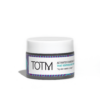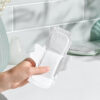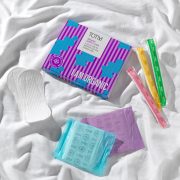This year a 63-year-old woman in the US won a battle against a big pharma brand claiming their talc baby powder was linked to her ovarian cancer.
Whilst this is undoubtedly very tragic and shocking news, it’s not a new story. The woman in question is, in fact, one of many women to link baby powder to a cancer diagnosis. Back in 2016, a California based woman also won a lawsuit with the same claims. She was the fifth woman to take the big pharma manufacturer to trial and win the case.
Don’t be surprised if you didn’t hear about this
Whilst this news was widely reported, it didn’t grab the big headlines. Only when digging a little deeper did I find out more about the risks. The International Agency for Research on Cancer (IARC) classifies the perineal (genital) use of talc-based body powder as “possibly carcinogenic to humans”. In fact, ConsumerSafety.org reports that medical studies have repeatedly shown a link between baby powder and ovarian tumours since 1971. Additionally, the NHS conducted a research trial back in 2016 assessing the link between talc and ovarian cancer. The study found a “33% increase in the risk of ovarian cancer with genital talc use.” They did warn that “caution must be taken when interpreting the risk” because of small sample sizes. However, a risk is still a risk.
To date, the big pharma brand in question is appealing the trial result, but with all this evidence it does make you think. What’s inside the products we are using?
Transparency over product ingredients
The truth is, as consumers we tend to buy from brands we know and trust. There’s a common perception that because a product has been around for years or is manufactured by a big brand, it can be trusted. But time and time again, well known, trusted products are exposed to be anything but trustworthy
It all links back to scientific evidence. There are very few in-depth reports, and studies giving hard-hitting facts about these products. There are studies (like the NHS one mentioned above) but these are often dismissed for providing weak evidence. Conclusions such as ‘it’s a minimal risk’ are often drawn from these studies. I don’t know about you but I think any risk is enough to make me question the products I’m buying or using.
How can you find the truth?
If only this question had a simple answer. Looking once again at the baby powder product that’s currently under scrutiny. A few years ago, research by the campaign for safe cosmetics discovered 2 chemicals in this product; formaldehyde and 1.4 dioxanes. Following this report, the pharma manufacturer released a report saying that they were selling formaldehyde-free versions in Europe and the rest of the world. They announced plans to reformulate products. So, before this research, consumers were unknowingly using potentially toxic ingredients. It’s a shame that this keeps happening. We should be aware of the ingredients in our products, and manufacturers should be forced to use the safest ingredients.
Now, let’s talk about tampons
I can’t conclude this article without addressing the feminine hygiene industry. An industry producing intimate products with unknown ingredients, for one of the most sensitive parts of your body. The FDA classifies tampons and pads as medical devices. Under this category, manufacturers do not need to list ingredients. And you do not have to look far to discover shocking claims about tampon contents. A report by Women’s Voices for The Earth, lists chlorine, pesticide residue, unknown fragrance, dioxins, and furans as some of the ‘chemicals of concern’ inside tampons.
Putting these very revealing claims aside, the lack of transparency is a big problem. The vagina is sensitive and absorbent. Award-winning science writer, Wendee Nicole explains that “mucous membranes in the vagina and vulva rapidly absorb chemicals without metabolizing them”. This high absorbency level is important to consider when choosing menstrual products. Or when using products such as talc on the genital area.
Even trace levels can be of concern. Clinical microbiology and pathology professor at New York University, Philip Tierno has addressed this issue. He states that “a woman uses approximately 11,400 tampons in her menstrual life, that’s exposure to dioxins 11,400 times.”
Taking this information into account, surely, companies should be forced to disclose the full list of ingredients in these products? The lack of transparency is very worrying.
Is anything safe?
I don’t know about you but this is the question at the forefront of my mind. Until we get transparency I guess we will never know. It’s important to always check product ingredients. I’ve been guilty of using products on my skin, hair, and face without even considering the ingredients. I can say for certain that I will not be doing this again going forward.
To get a better view of ingredients, because who knows what rayon or 1.4 dioxane actually is, I find sources such as this one very useful. If product ingredients are unclear or unknown then why take the risk?
Here’s what I recommend:
- Always check ingredients on products (especially body care products and cosmetics)
- Do your research. Get to know the ingredients to look out for!
- Shop around. Look for cleaner alternatives! If your local supermarket doesn’t stock much variety, look for a specialist independent store or shop online.
We would love to hear your thoughts on this very important topic. Do you always check product ingredients? Are you taking steps to look for cleaner products? Drop us a comment below or tweet us @totmorganic.





